Analysis of Financial Resource Management in Hospitality
VerifiedAdded on 2023/06/16
|9
|2895
|413
Report
AI Summary
This report provides a comprehensive analysis of financial resource management within the hospitality industry, focusing on Smart Resort Ltd. It begins by discussing Generally Accepted Accounting Principles (GAAP) and identifying various users of financial statements, along with their specific decision-making needs. The report then evaluates the financial statements that are of most interest to lenders and trade creditors. It also describes the components of an annual report supplement, including management discussion and analysis, notes to financial statements, and the auditor's report, while also discussing the concept of financial reporting. Finally, the report evaluates the financial performance of Smart Resort Ltd using ratio analysis for the past two years, providing insights into the company's financial health and operational efficiency. Desklib offers a range of solved assignments and study resources for students.
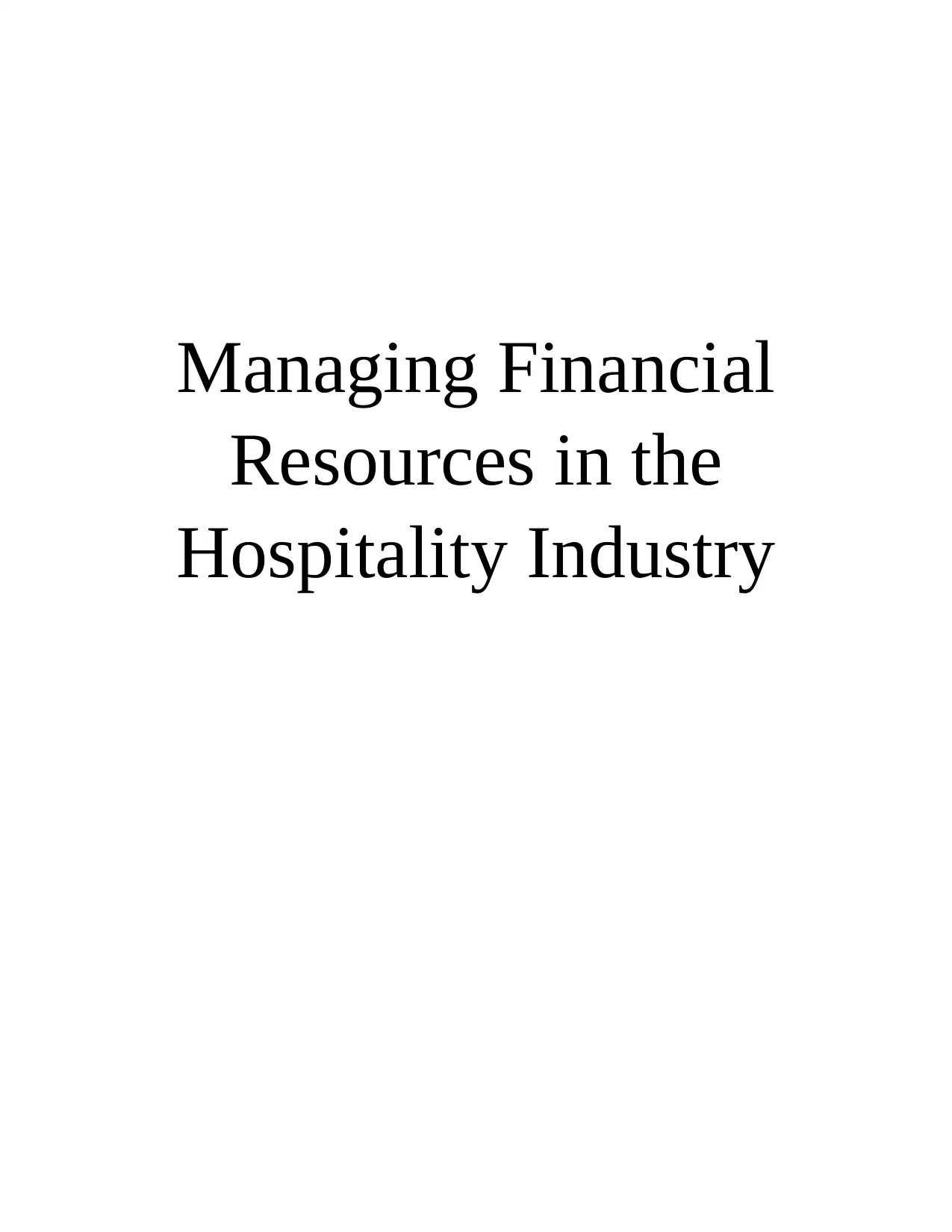
Managing Financial
Resources in the
Hospitality Industry
Resources in the
Hospitality Industry
Paraphrase This Document
Need a fresh take? Get an instant paraphrase of this document with our AI Paraphraser
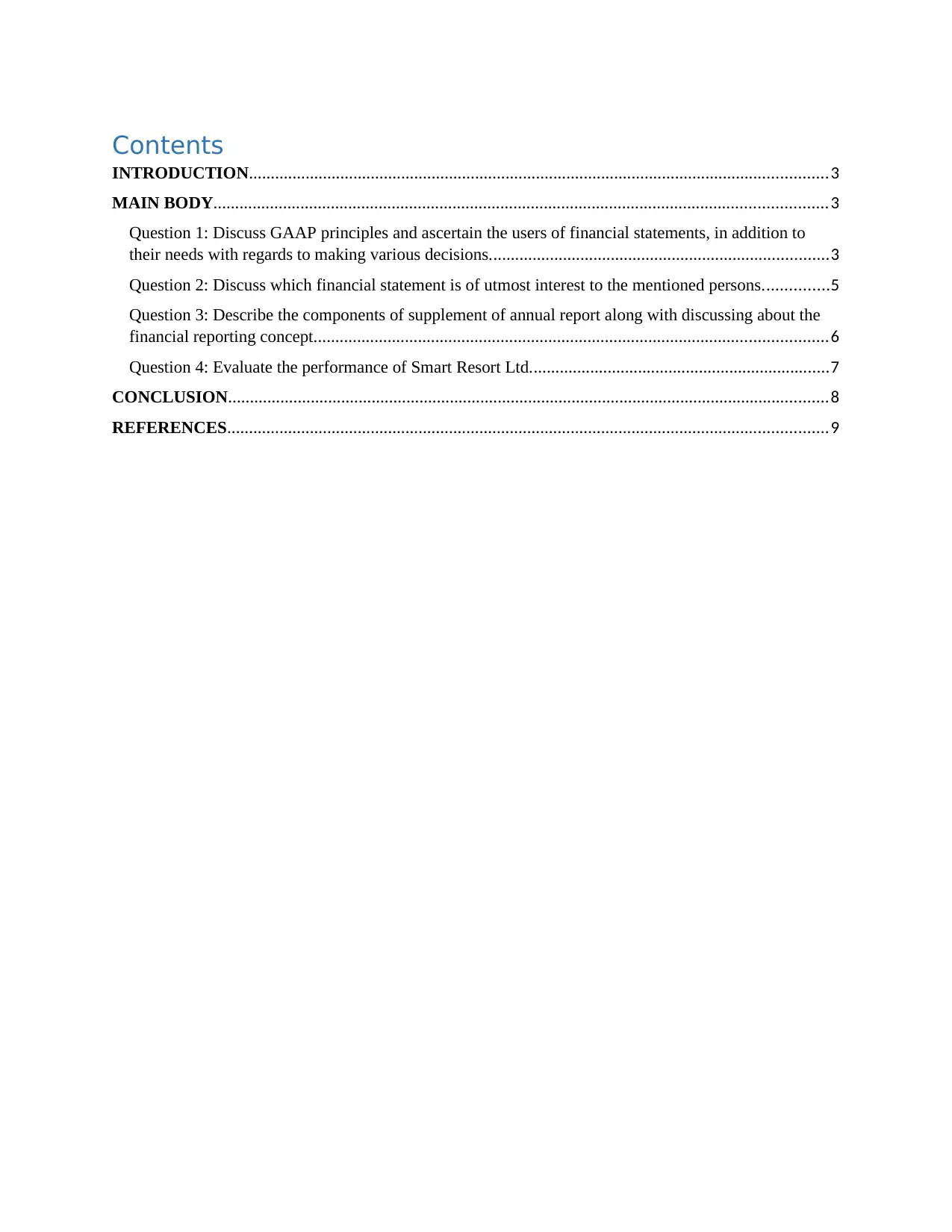
Contents
INTRODUCTION.....................................................................................................................................3
MAIN BODY.............................................................................................................................................3
Question 1: Discuss GAAP principles and ascertain the users of financial statements, in addition to
their needs with regards to making various decisions..............................................................................3
Question 2: Discuss which financial statement is of utmost interest to the mentioned persons...............5
Question 3: Describe the components of supplement of annual report along with discussing about the
financial reporting concept......................................................................................................................6
Question 4: Evaluate the performance of Smart Resort Ltd.....................................................................7
CONCLUSION..........................................................................................................................................8
REFERENCES..........................................................................................................................................9
INTRODUCTION.....................................................................................................................................3
MAIN BODY.............................................................................................................................................3
Question 1: Discuss GAAP principles and ascertain the users of financial statements, in addition to
their needs with regards to making various decisions..............................................................................3
Question 2: Discuss which financial statement is of utmost interest to the mentioned persons...............5
Question 3: Describe the components of supplement of annual report along with discussing about the
financial reporting concept......................................................................................................................6
Question 4: Evaluate the performance of Smart Resort Ltd.....................................................................7
CONCLUSION..........................................................................................................................................8
REFERENCES..........................................................................................................................................9
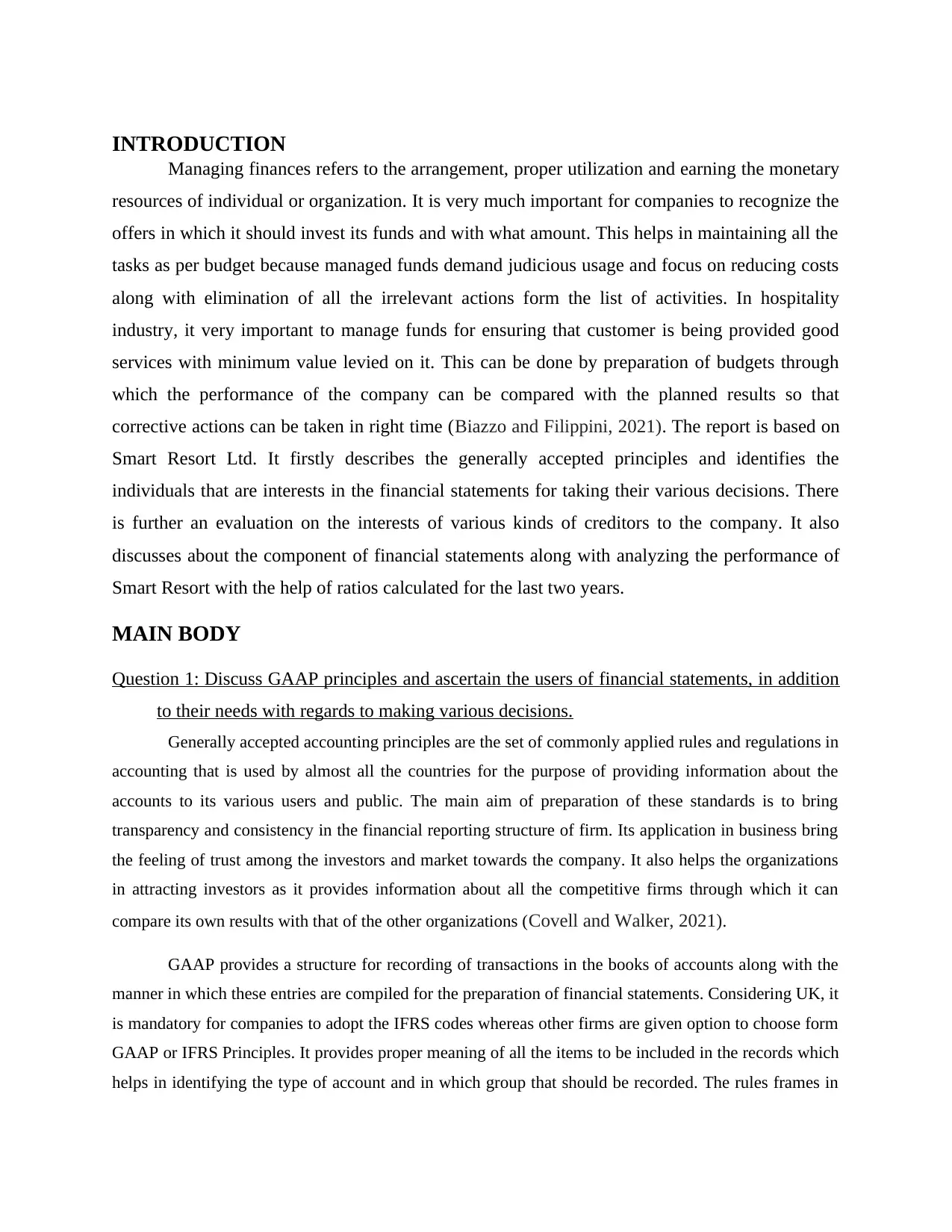
INTRODUCTION
Managing finances refers to the arrangement, proper utilization and earning the monetary
resources of individual or organization. It is very much important for companies to recognize the
offers in which it should invest its funds and with what amount. This helps in maintaining all the
tasks as per budget because managed funds demand judicious usage and focus on reducing costs
along with elimination of all the irrelevant actions form the list of activities. In hospitality
industry, it very important to manage funds for ensuring that customer is being provided good
services with minimum value levied on it. This can be done by preparation of budgets through
which the performance of the company can be compared with the planned results so that
corrective actions can be taken in right time (Biazzo and Filippini, 2021). The report is based on
Smart Resort Ltd. It firstly describes the generally accepted principles and identifies the
individuals that are interests in the financial statements for taking their various decisions. There
is further an evaluation on the interests of various kinds of creditors to the company. It also
discusses about the component of financial statements along with analyzing the performance of
Smart Resort with the help of ratios calculated for the last two years.
MAIN BODY
Question 1: Discuss GAAP principles and ascertain the users of financial statements, in addition
to their needs with regards to making various decisions.
Generally accepted accounting principles are the set of commonly applied rules and regulations in
accounting that is used by almost all the countries for the purpose of providing information about the
accounts to its various users and public. The main aim of preparation of these standards is to bring
transparency and consistency in the financial reporting structure of firm. Its application in business bring
the feeling of trust among the investors and market towards the company. It also helps the organizations
in attracting investors as it provides information about all the competitive firms through which it can
compare its own results with that of the other organizations (Covell and Walker, 2021).
GAAP provides a structure for recording of transactions in the books of accounts along with the
manner in which these entries are compiled for the preparation of financial statements. Considering UK, it
is mandatory for companies to adopt the IFRS codes whereas other firms are given option to choose form
GAAP or IFRS Principles. It provides proper meaning of all the items to be included in the records which
helps in identifying the type of account and in which group that should be recorded. The rules frames in
Managing finances refers to the arrangement, proper utilization and earning the monetary
resources of individual or organization. It is very much important for companies to recognize the
offers in which it should invest its funds and with what amount. This helps in maintaining all the
tasks as per budget because managed funds demand judicious usage and focus on reducing costs
along with elimination of all the irrelevant actions form the list of activities. In hospitality
industry, it very important to manage funds for ensuring that customer is being provided good
services with minimum value levied on it. This can be done by preparation of budgets through
which the performance of the company can be compared with the planned results so that
corrective actions can be taken in right time (Biazzo and Filippini, 2021). The report is based on
Smart Resort Ltd. It firstly describes the generally accepted principles and identifies the
individuals that are interests in the financial statements for taking their various decisions. There
is further an evaluation on the interests of various kinds of creditors to the company. It also
discusses about the component of financial statements along with analyzing the performance of
Smart Resort with the help of ratios calculated for the last two years.
MAIN BODY
Question 1: Discuss GAAP principles and ascertain the users of financial statements, in addition
to their needs with regards to making various decisions.
Generally accepted accounting principles are the set of commonly applied rules and regulations in
accounting that is used by almost all the countries for the purpose of providing information about the
accounts to its various users and public. The main aim of preparation of these standards is to bring
transparency and consistency in the financial reporting structure of firm. Its application in business bring
the feeling of trust among the investors and market towards the company. It also helps the organizations
in attracting investors as it provides information about all the competitive firms through which it can
compare its own results with that of the other organizations (Covell and Walker, 2021).
GAAP provides a structure for recording of transactions in the books of accounts along with the
manner in which these entries are compiled for the preparation of financial statements. Considering UK, it
is mandatory for companies to adopt the IFRS codes whereas other firms are given option to choose form
GAAP or IFRS Principles. It provides proper meaning of all the items to be included in the records which
helps in identifying the type of account and in which group that should be recorded. The rules frames in
⊘ This is a preview!⊘
Do you want full access?
Subscribe today to unlock all pages.

Trusted by 1+ million students worldwide
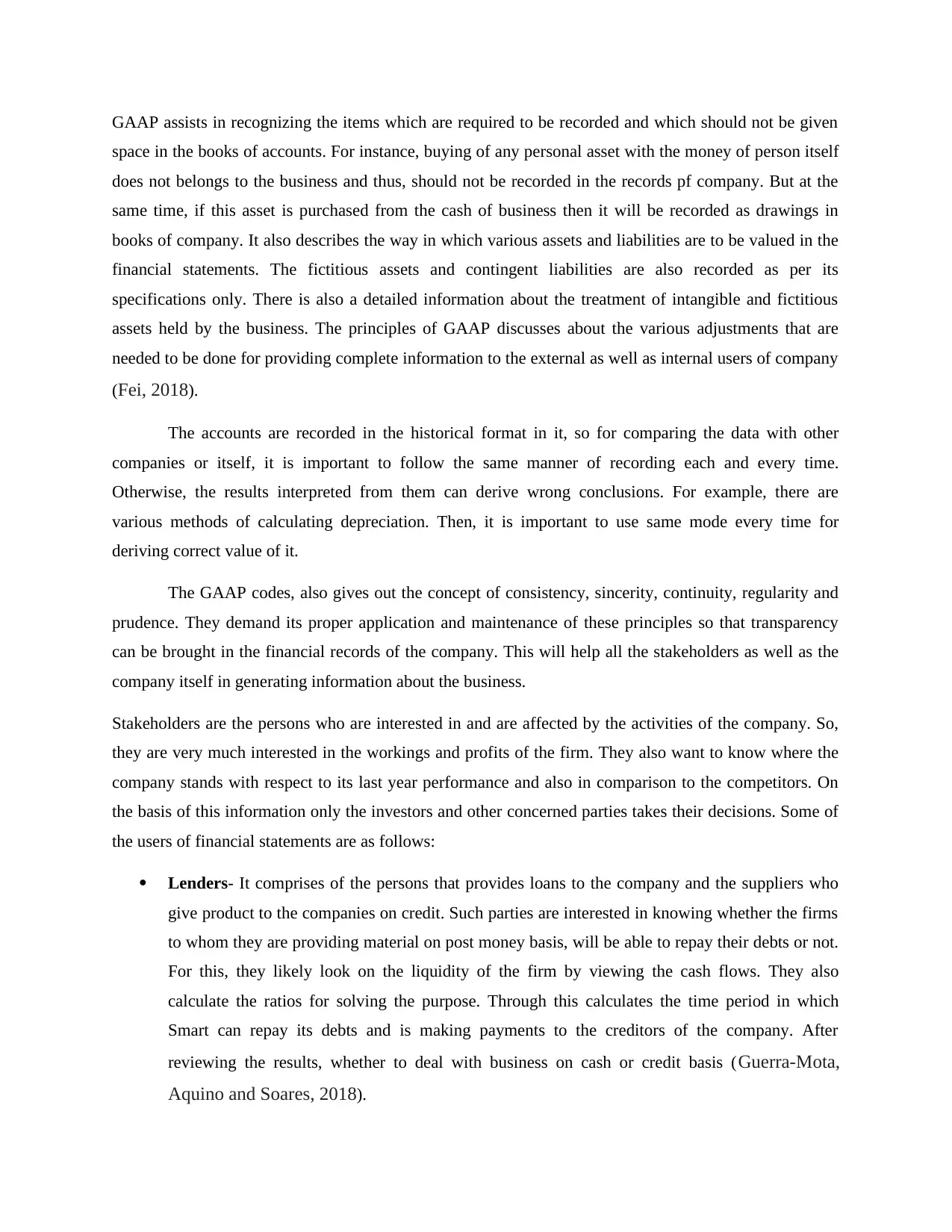
GAAP assists in recognizing the items which are required to be recorded and which should not be given
space in the books of accounts. For instance, buying of any personal asset with the money of person itself
does not belongs to the business and thus, should not be recorded in the records pf company. But at the
same time, if this asset is purchased from the cash of business then it will be recorded as drawings in
books of company. It also describes the way in which various assets and liabilities are to be valued in the
financial statements. The fictitious assets and contingent liabilities are also recorded as per its
specifications only. There is also a detailed information about the treatment of intangible and fictitious
assets held by the business. The principles of GAAP discusses about the various adjustments that are
needed to be done for providing complete information to the external as well as internal users of company
(Fei, 2018).
The accounts are recorded in the historical format in it, so for comparing the data with other
companies or itself, it is important to follow the same manner of recording each and every time.
Otherwise, the results interpreted from them can derive wrong conclusions. For example, there are
various methods of calculating depreciation. Then, it is important to use same mode every time for
deriving correct value of it.
The GAAP codes, also gives out the concept of consistency, sincerity, continuity, regularity and
prudence. They demand its proper application and maintenance of these principles so that transparency
can be brought in the financial records of the company. This will help all the stakeholders as well as the
company itself in generating information about the business.
Stakeholders are the persons who are interested in and are affected by the activities of the company. So,
they are very much interested in the workings and profits of the firm. They also want to know where the
company stands with respect to its last year performance and also in comparison to the competitors. On
the basis of this information only the investors and other concerned parties takes their decisions. Some of
the users of financial statements are as follows:
Lenders- It comprises of the persons that provides loans to the company and the suppliers who
give product to the companies on credit. Such parties are interested in knowing whether the firms
to whom they are providing material on post money basis, will be able to repay their debts or not.
For this, they likely look on the liquidity of the firm by viewing the cash flows. They also
calculate the ratios for solving the purpose. Through this calculates the time period in which
Smart can repay its debts and is making payments to the creditors of the company. After
reviewing the results, whether to deal with business on cash or credit basis (Guerra-Mota,
Aquino and Soares, 2018).
space in the books of accounts. For instance, buying of any personal asset with the money of person itself
does not belongs to the business and thus, should not be recorded in the records pf company. But at the
same time, if this asset is purchased from the cash of business then it will be recorded as drawings in
books of company. It also describes the way in which various assets and liabilities are to be valued in the
financial statements. The fictitious assets and contingent liabilities are also recorded as per its
specifications only. There is also a detailed information about the treatment of intangible and fictitious
assets held by the business. The principles of GAAP discusses about the various adjustments that are
needed to be done for providing complete information to the external as well as internal users of company
(Fei, 2018).
The accounts are recorded in the historical format in it, so for comparing the data with other
companies or itself, it is important to follow the same manner of recording each and every time.
Otherwise, the results interpreted from them can derive wrong conclusions. For example, there are
various methods of calculating depreciation. Then, it is important to use same mode every time for
deriving correct value of it.
The GAAP codes, also gives out the concept of consistency, sincerity, continuity, regularity and
prudence. They demand its proper application and maintenance of these principles so that transparency
can be brought in the financial records of the company. This will help all the stakeholders as well as the
company itself in generating information about the business.
Stakeholders are the persons who are interested in and are affected by the activities of the company. So,
they are very much interested in the workings and profits of the firm. They also want to know where the
company stands with respect to its last year performance and also in comparison to the competitors. On
the basis of this information only the investors and other concerned parties takes their decisions. Some of
the users of financial statements are as follows:
Lenders- It comprises of the persons that provides loans to the company and the suppliers who
give product to the companies on credit. Such parties are interested in knowing whether the firms
to whom they are providing material on post money basis, will be able to repay their debts or not.
For this, they likely look on the liquidity of the firm by viewing the cash flows. They also
calculate the ratios for solving the purpose. Through this calculates the time period in which
Smart can repay its debts and is making payments to the creditors of the company. After
reviewing the results, whether to deal with business on cash or credit basis (Guerra-Mota,
Aquino and Soares, 2018).
Paraphrase This Document
Need a fresh take? Get an instant paraphrase of this document with our AI Paraphraser
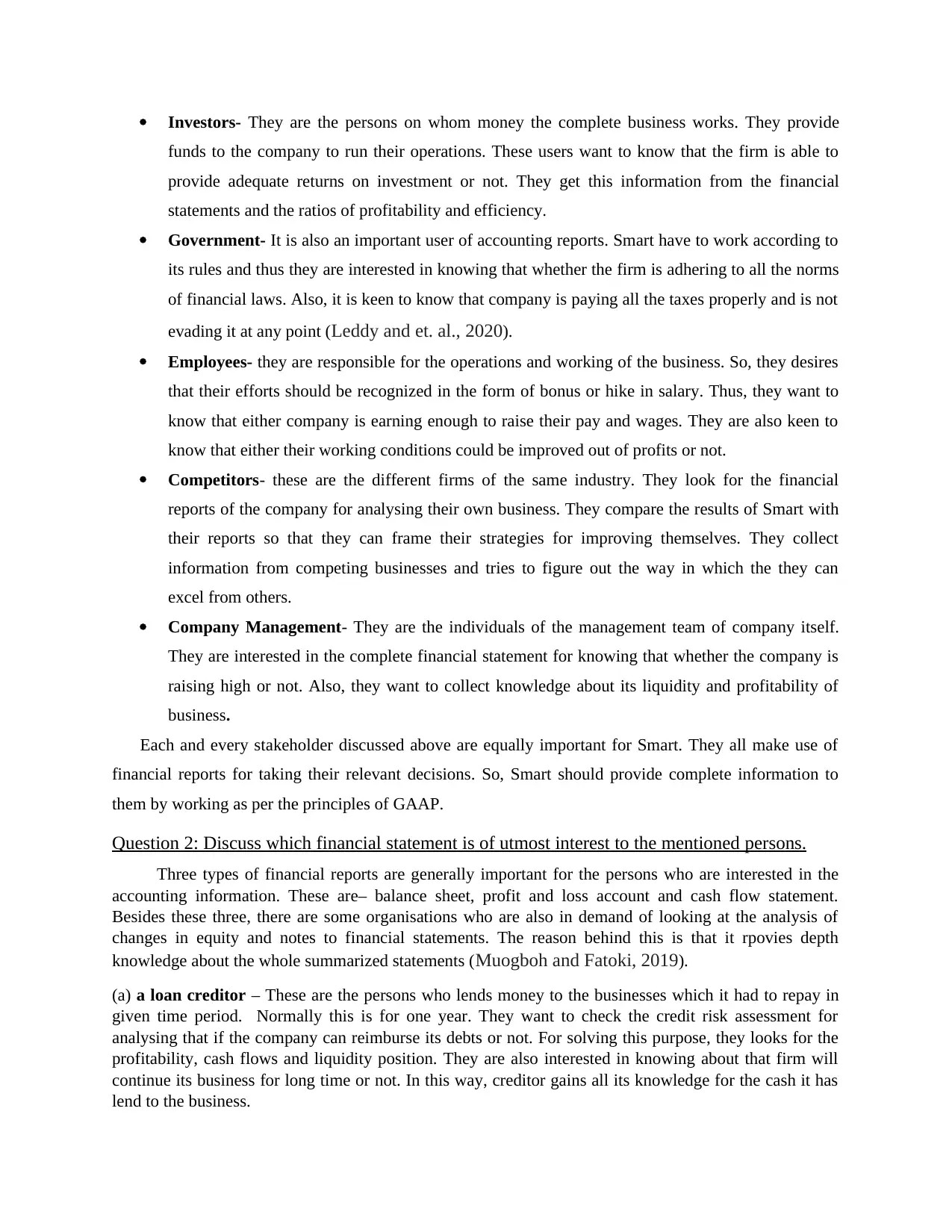
Investors- They are the persons on whom money the complete business works. They provide
funds to the company to run their operations. These users want to know that the firm is able to
provide adequate returns on investment or not. They get this information from the financial
statements and the ratios of profitability and efficiency.
Government- It is also an important user of accounting reports. Smart have to work according to
its rules and thus they are interested in knowing that whether the firm is adhering to all the norms
of financial laws. Also, it is keen to know that company is paying all the taxes properly and is not
evading it at any point (Leddy and et. al., 2020).
Employees- they are responsible for the operations and working of the business. So, they desires
that their efforts should be recognized in the form of bonus or hike in salary. Thus, they want to
know that either company is earning enough to raise their pay and wages. They are also keen to
know that either their working conditions could be improved out of profits or not.
Competitors- these are the different firms of the same industry. They look for the financial
reports of the company for analysing their own business. They compare the results of Smart with
their reports so that they can frame their strategies for improving themselves. They collect
information from competing businesses and tries to figure out the way in which the they can
excel from others.
Company Management- They are the individuals of the management team of company itself.
They are interested in the complete financial statement for knowing that whether the company is
raising high or not. Also, they want to collect knowledge about its liquidity and profitability of
business.
Each and every stakeholder discussed above are equally important for Smart. They all make use of
financial reports for taking their relevant decisions. So, Smart should provide complete information to
them by working as per the principles of GAAP.
Question 2: Discuss which financial statement is of utmost interest to the mentioned persons.
Three types of financial reports are generally important for the persons who are interested in the
accounting information. These are– balance sheet, profit and loss account and cash flow statement.
Besides these three, there are some organisations who are also in demand of looking at the analysis of
changes in equity and notes to financial statements. The reason behind this is that it rpovies depth
knowledge about the whole summarized statements (Muogboh and Fatoki, 2019).
(a) a loan creditor – These are the persons who lends money to the businesses which it had to repay in
given time period. Normally this is for one year. They want to check the credit risk assessment for
analysing that if the company can reimburse its debts or not. For solving this purpose, they looks for the
profitability, cash flows and liquidity position. They are also interested in knowing about that firm will
continue its business for long time or not. In this way, creditor gains all its knowledge for the cash it has
lend to the business.
funds to the company to run their operations. These users want to know that the firm is able to
provide adequate returns on investment or not. They get this information from the financial
statements and the ratios of profitability and efficiency.
Government- It is also an important user of accounting reports. Smart have to work according to
its rules and thus they are interested in knowing that whether the firm is adhering to all the norms
of financial laws. Also, it is keen to know that company is paying all the taxes properly and is not
evading it at any point (Leddy and et. al., 2020).
Employees- they are responsible for the operations and working of the business. So, they desires
that their efforts should be recognized in the form of bonus or hike in salary. Thus, they want to
know that either company is earning enough to raise their pay and wages. They are also keen to
know that either their working conditions could be improved out of profits or not.
Competitors- these are the different firms of the same industry. They look for the financial
reports of the company for analysing their own business. They compare the results of Smart with
their reports so that they can frame their strategies for improving themselves. They collect
information from competing businesses and tries to figure out the way in which the they can
excel from others.
Company Management- They are the individuals of the management team of company itself.
They are interested in the complete financial statement for knowing that whether the company is
raising high or not. Also, they want to collect knowledge about its liquidity and profitability of
business.
Each and every stakeholder discussed above are equally important for Smart. They all make use of
financial reports for taking their relevant decisions. So, Smart should provide complete information to
them by working as per the principles of GAAP.
Question 2: Discuss which financial statement is of utmost interest to the mentioned persons.
Three types of financial reports are generally important for the persons who are interested in the
accounting information. These are– balance sheet, profit and loss account and cash flow statement.
Besides these three, there are some organisations who are also in demand of looking at the analysis of
changes in equity and notes to financial statements. The reason behind this is that it rpovies depth
knowledge about the whole summarized statements (Muogboh and Fatoki, 2019).
(a) a loan creditor – These are the persons who lends money to the businesses which it had to repay in
given time period. Normally this is for one year. They want to check the credit risk assessment for
analysing that if the company can reimburse its debts or not. For solving this purpose, they looks for the
profitability, cash flows and liquidity position. They are also interested in knowing about that firm will
continue its business for long time or not. In this way, creditor gains all its knowledge for the cash it has
lend to the business.
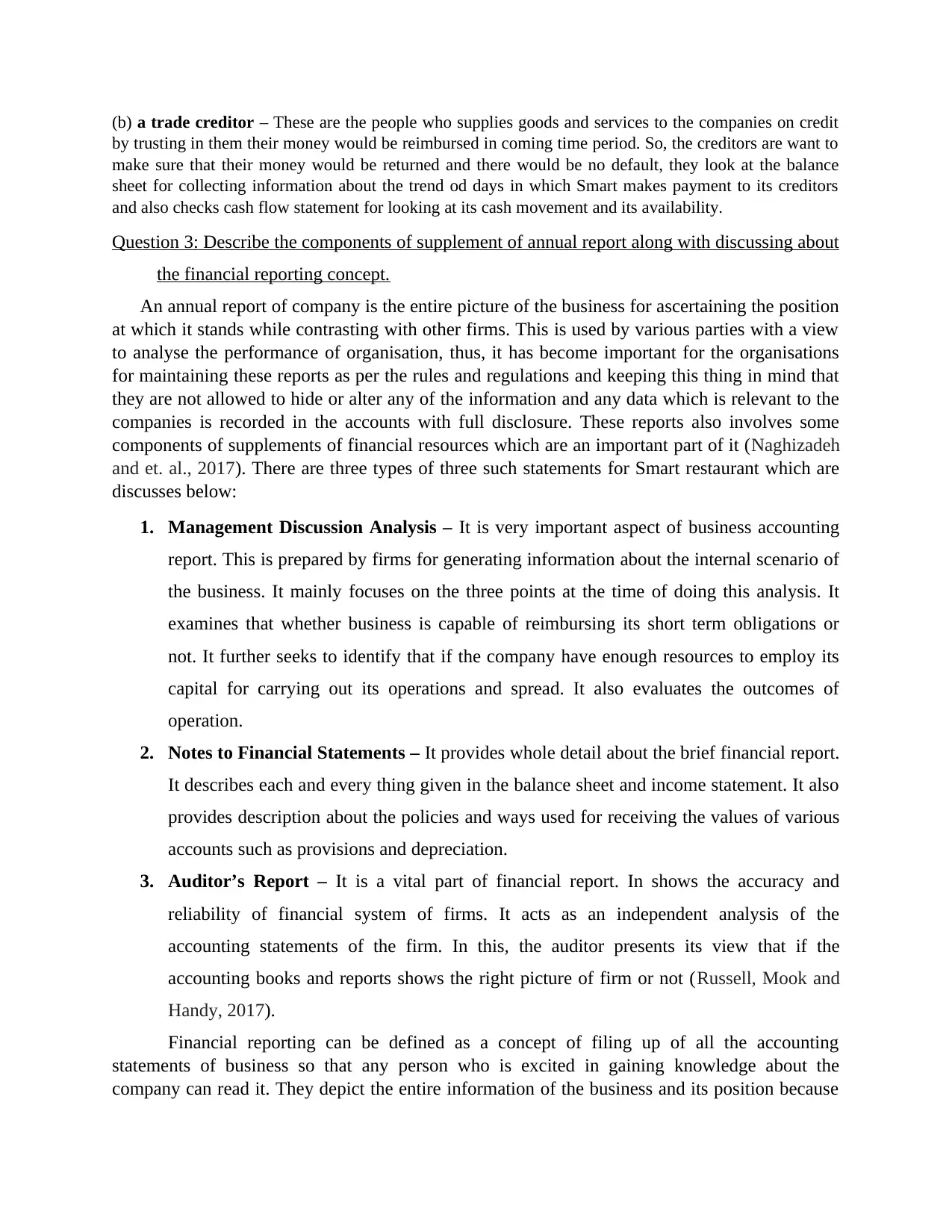
(b) a trade creditor – These are the people who supplies goods and services to the companies on credit
by trusting in them their money would be reimbursed in coming time period. So, the creditors are want to
make sure that their money would be returned and there would be no default, they look at the balance
sheet for collecting information about the trend od days in which Smart makes payment to its creditors
and also checks cash flow statement for looking at its cash movement and its availability.
Question 3: Describe the components of supplement of annual report along with discussing about
the financial reporting concept.
An annual report of company is the entire picture of the business for ascertaining the position
at which it stands while contrasting with other firms. This is used by various parties with a view
to analyse the performance of organisation, thus, it has become important for the organisations
for maintaining these reports as per the rules and regulations and keeping this thing in mind that
they are not allowed to hide or alter any of the information and any data which is relevant to the
companies is recorded in the accounts with full disclosure. These reports also involves some
components of supplements of financial resources which are an important part of it (Naghizadeh
and et. al., 2017). There are three types of three such statements for Smart restaurant which are
discusses below:
1. Management Discussion Analysis – It is very important aspect of business accounting
report. This is prepared by firms for generating information about the internal scenario of
the business. It mainly focuses on the three points at the time of doing this analysis. It
examines that whether business is capable of reimbursing its short term obligations or
not. It further seeks to identify that if the company have enough resources to employ its
capital for carrying out its operations and spread. It also evaluates the outcomes of
operation.
2. Notes to Financial Statements – It provides whole detail about the brief financial report.
It describes each and every thing given in the balance sheet and income statement. It also
provides description about the policies and ways used for receiving the values of various
accounts such as provisions and depreciation.
3. Auditor’s Report – It is a vital part of financial report. In shows the accuracy and
reliability of financial system of firms. It acts as an independent analysis of the
accounting statements of the firm. In this, the auditor presents its view that if the
accounting books and reports shows the right picture of firm or not (Russell, Mook and
Handy, 2017).
Financial reporting can be defined as a concept of filing up of all the accounting
statements of business so that any person who is excited in gaining knowledge about the
company can read it. They depict the entire information of the business and its position because
by trusting in them their money would be reimbursed in coming time period. So, the creditors are want to
make sure that their money would be returned and there would be no default, they look at the balance
sheet for collecting information about the trend od days in which Smart makes payment to its creditors
and also checks cash flow statement for looking at its cash movement and its availability.
Question 3: Describe the components of supplement of annual report along with discussing about
the financial reporting concept.
An annual report of company is the entire picture of the business for ascertaining the position
at which it stands while contrasting with other firms. This is used by various parties with a view
to analyse the performance of organisation, thus, it has become important for the organisations
for maintaining these reports as per the rules and regulations and keeping this thing in mind that
they are not allowed to hide or alter any of the information and any data which is relevant to the
companies is recorded in the accounts with full disclosure. These reports also involves some
components of supplements of financial resources which are an important part of it (Naghizadeh
and et. al., 2017). There are three types of three such statements for Smart restaurant which are
discusses below:
1. Management Discussion Analysis – It is very important aspect of business accounting
report. This is prepared by firms for generating information about the internal scenario of
the business. It mainly focuses on the three points at the time of doing this analysis. It
examines that whether business is capable of reimbursing its short term obligations or
not. It further seeks to identify that if the company have enough resources to employ its
capital for carrying out its operations and spread. It also evaluates the outcomes of
operation.
2. Notes to Financial Statements – It provides whole detail about the brief financial report.
It describes each and every thing given in the balance sheet and income statement. It also
provides description about the policies and ways used for receiving the values of various
accounts such as provisions and depreciation.
3. Auditor’s Report – It is a vital part of financial report. In shows the accuracy and
reliability of financial system of firms. It acts as an independent analysis of the
accounting statements of the firm. In this, the auditor presents its view that if the
accounting books and reports shows the right picture of firm or not (Russell, Mook and
Handy, 2017).
Financial reporting can be defined as a concept of filing up of all the accounting
statements of business so that any person who is excited in gaining knowledge about the
company can read it. They depict the entire information of the business and its position because
⊘ This is a preview!⊘
Do you want full access?
Subscribe today to unlock all pages.

Trusted by 1+ million students worldwide
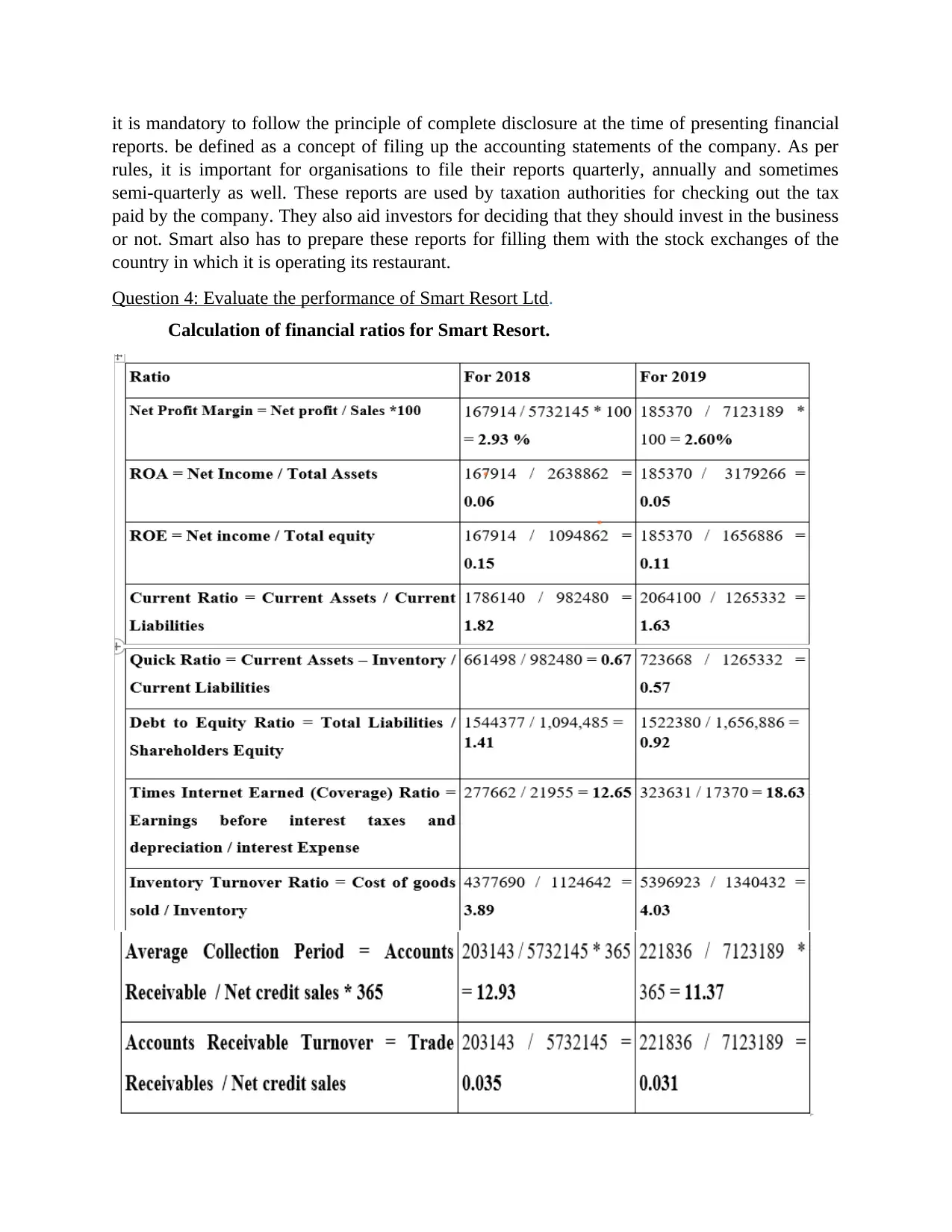
it is mandatory to follow the principle of complete disclosure at the time of presenting financial
reports. be defined as a concept of filing up the accounting statements of the company. As per
rules, it is important for organisations to file their reports quarterly, annually and sometimes
semi-quarterly as well. These reports are used by taxation authorities for checking out the tax
paid by the company. They also aid investors for deciding that they should invest in the business
or not. Smart also has to prepare these reports for filling them with the stock exchanges of the
country in which it is operating its restaurant.
Question 4: Evaluate the performance of Smart Resort Ltd.
Calculation of financial ratios for Smart Resort.
reports. be defined as a concept of filing up the accounting statements of the company. As per
rules, it is important for organisations to file their reports quarterly, annually and sometimes
semi-quarterly as well. These reports are used by taxation authorities for checking out the tax
paid by the company. They also aid investors for deciding that they should invest in the business
or not. Smart also has to prepare these reports for filling them with the stock exchanges of the
country in which it is operating its restaurant.
Question 4: Evaluate the performance of Smart Resort Ltd.
Calculation of financial ratios for Smart Resort.
Paraphrase This Document
Need a fresh take? Get an instant paraphrase of this document with our AI Paraphraser
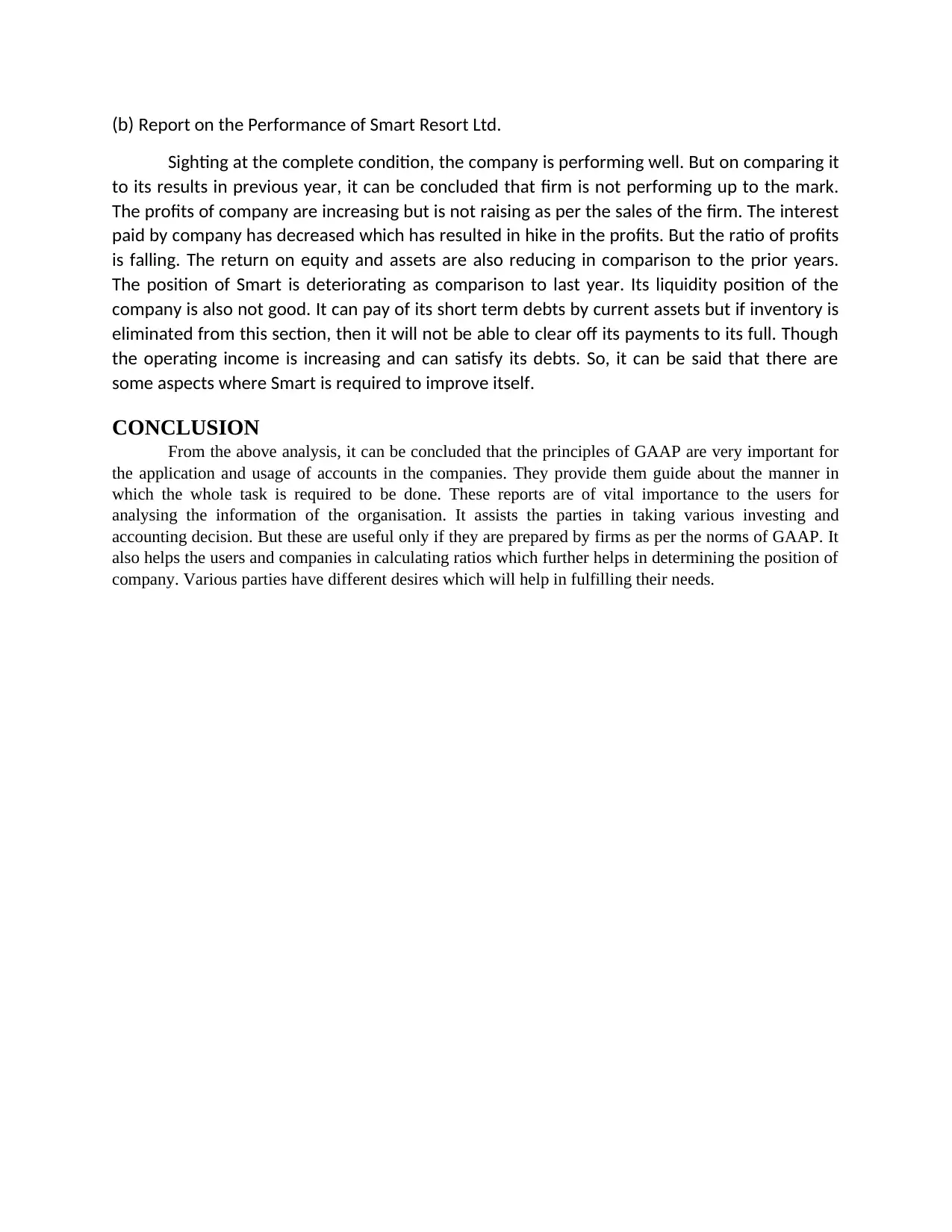
(b) Report on the Performance of Smart Resort Ltd.
Sighting at the complete condition, the company is performing well. But on comparing it
to its results in previous year, it can be concluded that firm is not performing up to the mark.
The profits of company are increasing but is not raising as per the sales of the firm. The interest
paid by company has decreased which has resulted in hike in the profits. But the ratio of profits
is falling. The return on equity and assets are also reducing in comparison to the prior years.
The position of Smart is deteriorating as comparison to last year. Its liquidity position of the
company is also not good. It can pay of its short term debts by current assets but if inventory is
eliminated from this section, then it will not be able to clear off its payments to its full. Though
the operating income is increasing and can satisfy its debts. So, it can be said that there are
some aspects where Smart is required to improve itself.
CONCLUSION
From the above analysis, it can be concluded that the principles of GAAP are very important for
the application and usage of accounts in the companies. They provide them guide about the manner in
which the whole task is required to be done. These reports are of vital importance to the users for
analysing the information of the organisation. It assists the parties in taking various investing and
accounting decision. But these are useful only if they are prepared by firms as per the norms of GAAP. It
also helps the users and companies in calculating ratios which further helps in determining the position of
company. Various parties have different desires which will help in fulfilling their needs.
Sighting at the complete condition, the company is performing well. But on comparing it
to its results in previous year, it can be concluded that firm is not performing up to the mark.
The profits of company are increasing but is not raising as per the sales of the firm. The interest
paid by company has decreased which has resulted in hike in the profits. But the ratio of profits
is falling. The return on equity and assets are also reducing in comparison to the prior years.
The position of Smart is deteriorating as comparison to last year. Its liquidity position of the
company is also not good. It can pay of its short term debts by current assets but if inventory is
eliminated from this section, then it will not be able to clear off its payments to its full. Though
the operating income is increasing and can satisfy its debts. So, it can be said that there are
some aspects where Smart is required to improve itself.
CONCLUSION
From the above analysis, it can be concluded that the principles of GAAP are very important for
the application and usage of accounts in the companies. They provide them guide about the manner in
which the whole task is required to be done. These reports are of vital importance to the users for
analysing the information of the organisation. It assists the parties in taking various investing and
accounting decision. But these are useful only if they are prepared by firms as per the norms of GAAP. It
also helps the users and companies in calculating ratios which further helps in determining the position of
company. Various parties have different desires which will help in fulfilling their needs.

REFERENCES
(Books and Journals)
Biazzo, S. and Filippini, R., 2021. Managing the Development Portfolio. In Product Innovation
Management (pp. 159-175). Springer, Cham.
Covell, D. and Walker, S., 2021. Managing intercollegiate athletics. Routledge.
Fei, J. ed., 2018. Managing human resources in the shipping industry. Routledge.
Guerra-Mota, M., Aquino, T. and Soares, I., 2018. European electricity utilities managing energy
transition challenges. Environment, Development and Sustainability. 20(1). pp.213-230.
Leddy, A.M. and et. al., 2020. Exploring the role of social capital in managing food insecurity
among older women in the United States. Social Science & Medicine. 265. p.113492.
Muogboh, O.S. and Fatoki, J.G., 2019. 17 Managing Healthcare Logistics. Health Service
Marketing Management in Africa.
Naghizadeh, M. and et. al., 2017. Managing integration in complex product systems: The
experience of the IR-150 aircraft design program. Technological forecasting and social
change. 122. pp.253-261.
Russell, A.R., Mook, L. and Handy, F., 2017. Interchangeability of labor: managing a mixed
paid and volunteer workforce. In The nonprofit human resource management
handbook (pp. 271-284). Routledge.
(Books and Journals)
Biazzo, S. and Filippini, R., 2021. Managing the Development Portfolio. In Product Innovation
Management (pp. 159-175). Springer, Cham.
Covell, D. and Walker, S., 2021. Managing intercollegiate athletics. Routledge.
Fei, J. ed., 2018. Managing human resources in the shipping industry. Routledge.
Guerra-Mota, M., Aquino, T. and Soares, I., 2018. European electricity utilities managing energy
transition challenges. Environment, Development and Sustainability. 20(1). pp.213-230.
Leddy, A.M. and et. al., 2020. Exploring the role of social capital in managing food insecurity
among older women in the United States. Social Science & Medicine. 265. p.113492.
Muogboh, O.S. and Fatoki, J.G., 2019. 17 Managing Healthcare Logistics. Health Service
Marketing Management in Africa.
Naghizadeh, M. and et. al., 2017. Managing integration in complex product systems: The
experience of the IR-150 aircraft design program. Technological forecasting and social
change. 122. pp.253-261.
Russell, A.R., Mook, L. and Handy, F., 2017. Interchangeability of labor: managing a mixed
paid and volunteer workforce. In The nonprofit human resource management
handbook (pp. 271-284). Routledge.
⊘ This is a preview!⊘
Do you want full access?
Subscribe today to unlock all pages.

Trusted by 1+ million students worldwide
1 out of 9
Related Documents
Your All-in-One AI-Powered Toolkit for Academic Success.
+13062052269
info@desklib.com
Available 24*7 on WhatsApp / Email
![[object Object]](/_next/static/media/star-bottom.7253800d.svg)
Unlock your academic potential
Copyright © 2020–2026 A2Z Services. All Rights Reserved. Developed and managed by ZUCOL.


